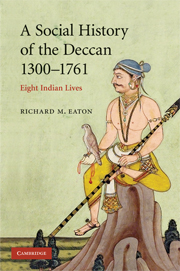Book contents
- Frontmatter
- Introduction
- 1 Pratapa Rudra (R. 1289–1323): the demise of the regional kingdom
- 2 Muhammad Gisu Daraz (1321–1422): Muslim piety and state authority
- 3 Mahmud Gawan (1411–1481): Deccanis and Westerners
- 4 Rama Raya (1484–1565): élite mobility in a Persianized world
- 5 Malik Ambar (1548–1626): the rise and fall of military slavery
- 6 Tukaram (1608–1649): non-brahmin religious movements
- 7 Papadu (fl. 1695–1710): social banditry in Mughal Telangana
- 8 Tarabai (1675–1761): the rise of Brahmins in politics
- Select bibliography
- Index
- Plate Section"
- References
7 - Papadu (fl. 1695–1710): social banditry in Mughal Telangana
Published online by Cambridge University Press: 28 March 2008
- Frontmatter
- Introduction
- 1 Pratapa Rudra (R. 1289–1323): the demise of the regional kingdom
- 2 Muhammad Gisu Daraz (1321–1422): Muslim piety and state authority
- 3 Mahmud Gawan (1411–1481): Deccanis and Westerners
- 4 Rama Raya (1484–1565): élite mobility in a Persianized world
- 5 Malik Ambar (1548–1626): the rise and fall of military slavery
- 6 Tukaram (1608–1649): non-brahmin religious movements
- 7 Papadu (fl. 1695–1710): social banditry in Mughal Telangana
- 8 Tarabai (1675–1761): the rise of Brahmins in politics
- Select bibliography
- Index
- Plate Section"
- References
Summary
Traveling alone, Papra [Papadu] appeared in Hasanabad, a village two marches away that he himself had settled. Coming across a toddy-seller, he said to the man, ‘Bring me some good toddy.’ But despite the fugitive’s best efforts to disguise himself, the toddy-seller recognized his manner of speech. He scrutinized his face. He knew it was Papra.
Khafi Khan (d. c.1731)The visitor to Shahpur, located some fifty miles northeast of Hyderabad near the main road to Warangal, cannot mistake its two most prominent landmarks – the hill-fort, and the bust prominently situated in the village square. The bust is of Sarvayi Papadu, Shahpur's most notorious native son. Commissioned in 1998 by the Telugu University, Warangal, this image of Papadu was sculpted on the basis of a portrait dating to 1750–80 (see Plate 12). In both the painting and the bust, the intense gaze in his eyes, his formidable moustache, and the falcon perched on his wrist all project a fearsome, swashbuckling demeanor.
Captured and executed by Mughal authorities in 1710 as a highwayman and bandit, Papadu would become celebrated in local memory as a hero who boldly defied imperial authority, indeed, most any authority. Shahpur's other prominent landmark, the fort, rests atop a hill immediately to the north of the village and consists of a square, stone-walled compound built around a cube-shaped watchtower (see Plate 13). Here, between c. 1701 and 1709 Mughal troops besieged Papadu and his men no fewer than four times.
Papadu's brief and turbulent career is of great interest from the standpoint of social history. His stubborn resistance to various forms of authority, and his manifest success in garnering support for his cause, forced people of diverse backgrounds to make crucial choices. Moreover, since he aroused considerable concern in official circles, which in turn attracted the attention of imperial news-writers, his recorded activities allow us to glimpse fault lines in the social order that would otherwise have remained concealed from view.
Keywords
- Type
- Chapter
- Information
- A Social History of the Deccan, 1300–1761Eight Indian Lives, pp. 155 - 176Publisher: Cambridge University PressPrint publication year: 2005



